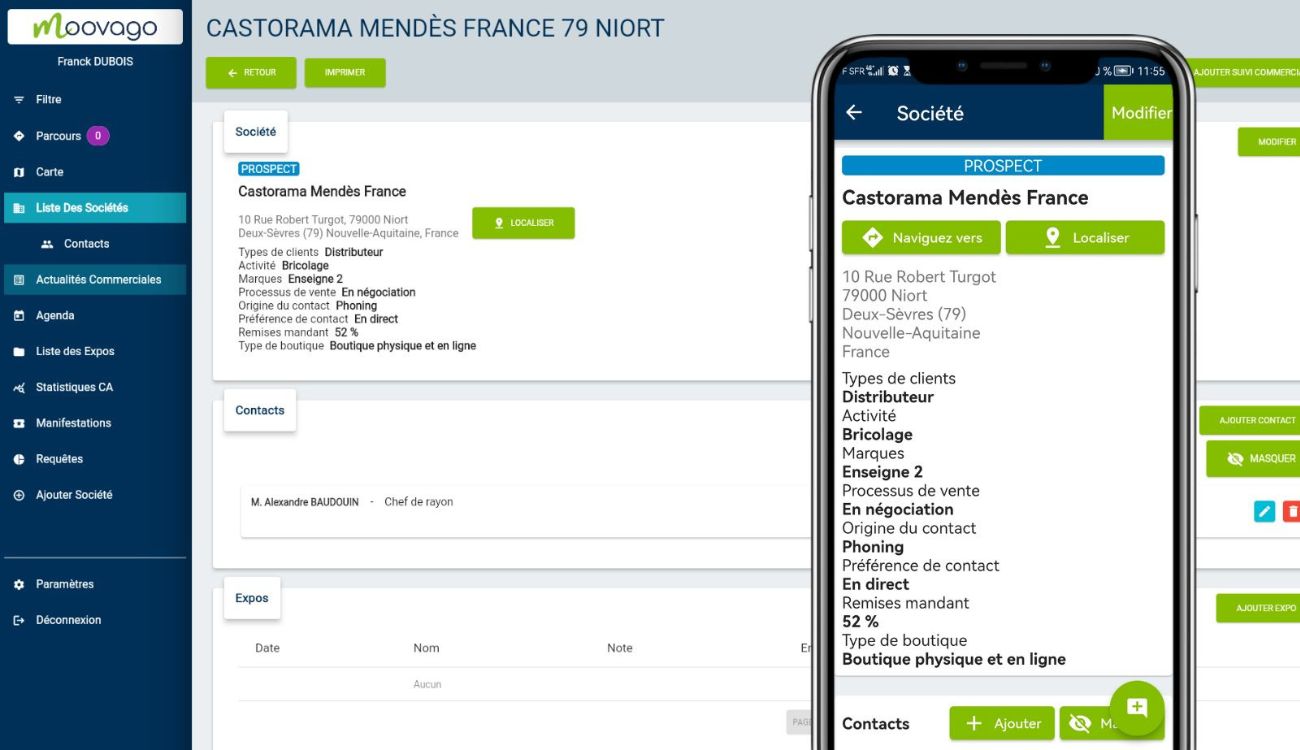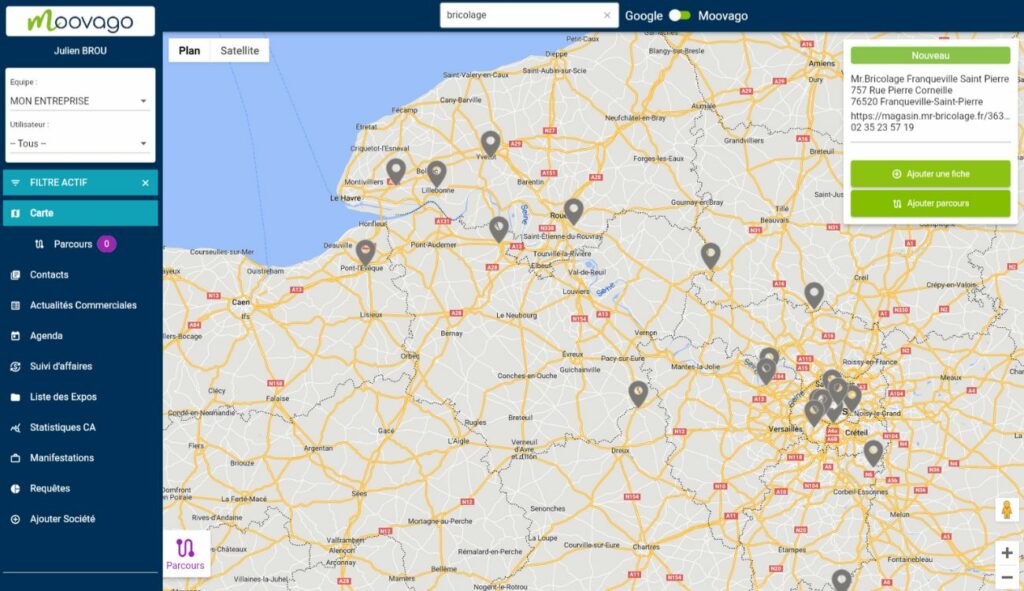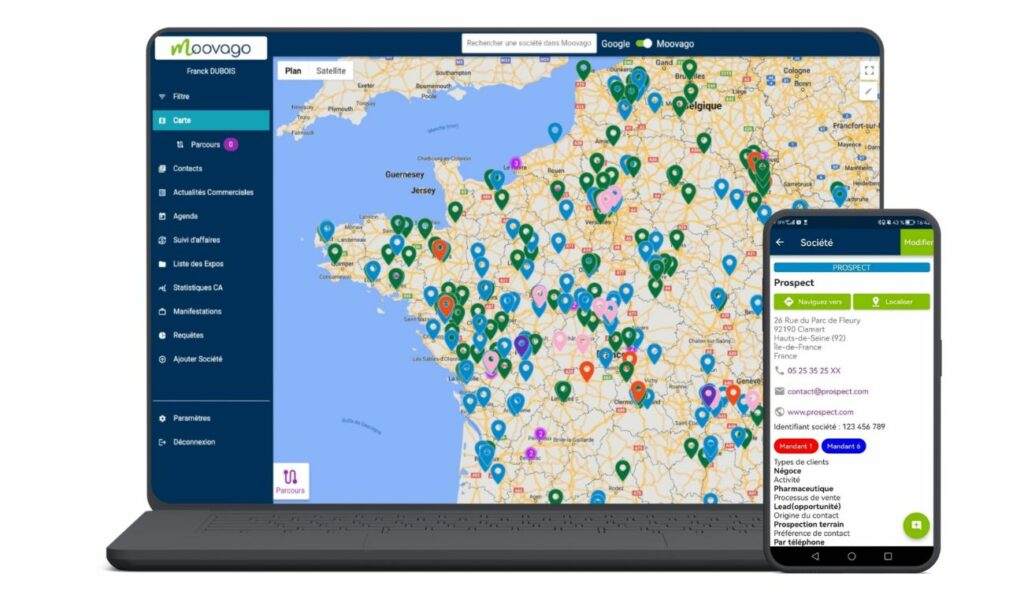For a traveling salesperson, developing a customer portfolio is at the heart of the job. More than a simple accumulation of contacts, it’s a strategic process requiring method, organization and rigorous follow-up.
In this comprehensive guide, discover how to structure your approach to the field, optimize your rounds and use the right tools to grow your customer portfolio.
Whether you’re an independent sales agent, a sales representative or a salaried sales representative, discover practical ways to boost your customer portfolio.
1. Define customer portfolio development priorities
Before you dive headlong into prospecting, let’s take a moment to define exactly what it means to ‘develop your customer portfolio’ and how to approach it strategically.
Expand your VS portfolio Increase sales revenue
📚 The 3 pillars of business development
- Increase the number of customers: Win new customers through active prospecting
- Increase value per customer: Optimize the average basket of your existing customers
- Increase conversion rates: Improve your sales efficiency
Understanding your market by defining your target clientele
To develop your customer portfolio effectively, you need to know exactly who to target.
TheICP (Ideal Customer Profile, also known as the Buyer Persona) enables us to define your ideal customer according to various criteria: type of company, size, sector of activity, specific problems encountered.
To define your KPI, ask yourself these essential questions:
- What are their needs and issues?
- What is their average budget?
- What sectors do they work in?
- What is their company size?
- Who are the decision-makers?
With a CRM designed for field sales representatives, you can easily segment your customer file according to your own criteria (those of your personas) and thus adapt your sales approach to each type of prospect.
2. Before expanding your customer portfolio: make sure it's healthy
Now that you’ve defined your development strategy, let’s make sure that your current portfolio is ready for this growth. Because before you can conquer new territories, you need to consolidate your foundations.
Segment your base, the base
Want to boost the development of your customer portfolio? Start by organizing the one you already have! Segmentation involves dividing your customer base into homogeneous groups sharing common characteristics. This approach enables you to tailor your sales approach to each segment to maximize your results.
Classic segmentation criteria include :
- Demographics: company size, sector of activity, seniority
- Behavioral: purchase frequency, average basket, loyalty
- Geographic: catchment areas, regions, departments
- Psychographic: values, purchasing motivations, decision-making profile
To enrich your portfolio, you need to have it to hand
Gone are the days of Excel files on the office computer! Today, your customer portfolio has to follow you everywhere. Centralizing information in a mobile CRM is a game-changer for field sales representatives.
Just imagine: you’ve just come from a meeting at a customer’s premises, and you immediately enter your report, schedule the next action and consult who to see in the neighborhood. All from your smartphone! That’s the advantage of a mobile CRM used for customer follow-up, like Moovago.
Expand your customer portfolio with Moovago
Find the files of all your customers and prospects with for each one :
- Contact information,
- Businesses, documents and stages in the commercial process,
- History of all your exchanges (appointments, reminders, etc.)
- Customer segmentation at a glance,
- Deposited samples,
- And much, much more!

3. Acquisition techniques to develop your customer portfolio
Is your portfolio now organized and centralized? Perfect! Now it’s time to go on the offensive and explore the acquisition techniques that will really get your business off the ground.
Mapping your customers: the heart of your field approach
Geographically visualizing your customers and prospects allows you to quickly reveal untapped opportunities.
Areas with low commercial density offer immediate development potential, as do business clusters where proximity facilitates group visits.
Modern mapping goes beyond simple dots on a map. By color-coding your contacts (active customers, hot prospects, scheduled appointments, pending tasks), you create a visual dashboard of your sales activity. This approach lets you identify at a glance :
- Conquering white zones
- Saturated areas where to optimize your efforts
- Group tour opportunities
Google search integrated into Moovago
Moovago integrates a unique feature: Google search directly on your business card! Enter an activity, a profession, a company name or a brand name, and instantly visualize these potential contacts. Access their contact details, approach them, then save them in your portfolio with a single click. From prospecting to integration, everything’s done from the same interface!

Optimize your travel
As a field sales representative, you spend a considerable amount of time on the road. An ill-prepared round can cost you precious minutes or even hours.
Intelligent round planning can significantly increase the number of productive visits per day. Route optimization reduces downtime and maximizes time spent with customers and prospects.
Before you even start your vehicle, you need to know :
- If your round is feasible within the timeframe (day, week, etc.).
- Your precise arrival times at each customer site.
- Waiting times between appointments to optimize your organization.
A goodround optimization tool can save up to 50% of time on organizing rounds, while automatically calculating the fastest route. That’s just as much time saved in developing your customer portfolio!
Networking and referrals
Word-of-mouth remains your best sales tool! Your satisfied customers are your ambassadors: identify the right moment to ask for recommendations, but always do so after a successful sale.
Trade shows also concentrate your prospects: prepare your visit with precise objectives and ensure rapid post-event follow-up.
Resource to discover: Finding trade shows when you’re a sales representative, List of trade shows 2025
Phoning
Contrary to popular belief, telephone and field sales are a winning combination when it comes to developing your customer portfolio! The two channels complement each other perfectly:
- Preparing visits: A preliminary call qualifies the prospect and confirms interest. No more empty visits!
- Maximize your rounds: Turn the downtime between appointments into targeted telephone prospecting sessions. Your car becomes your second office.
- Post-visit follow-up: A follow-up call just after a visit keeps the relationship warm and increases your chances of conversion.
- Handling the unexpected: Last-minute cancellation? Convert this time slot into a productive phoning session rather than going home empty-handed.
This hybrid field/phoning approach multiplies your points of contact and accelerates the development of a customer portfolio!
4. Successful visits to develop your customer portfolio
You’ve identified your prospects and optimized your rounds. But how do you turn these opportunities into real customers? It all comes down to the sales call. Let’s discover together the keys to a successful appointment.
Preparation: the key to a successful visit
You know the old adage: “A well-prepared visit is half the battle! The success of your sales meetings depends on how well you prepare before you ring the customer’s doorbell. Careful preparation transforms every visit into a development opportunity for your portfolio.
With an effective mobile CRM, all information is at your fingertips:
- Consult the customer’s complete history from your smartphone (past exchanges and purchases, expectations, problems, etc.).
- Check the latest interactions and orders.
- Access your colleagues’ notes.
- Identify cross-selling opportunities.
- Tailor your arguments and prepare for objections.
Active listening and handling objections
Developing your customer portfolio means first and foremost understanding your prospects’ real needs. The SPIN method structures your discovery in four phases:
- Situation: Where is the company today?
- Problem: What challenges does it face?
- Implication: What are the consequences of these problems?
- Necessity: What solution would solve them?
This approach transforms objections into opportunities for constructive dialogue. Instead of seeing them as obstacles, consider them as requests for additional information to refine your value proposition.
At the meeting: adapt your style to your prospect's profile
The preparation is done. Now it’s time for the art of the meeting!
Knowing how to identify and adapt to the profile of the buyer in front of you makes the difference between a productive visit and a meeting that goes nowhere. This adaptation of your communication improves the quality of the exchange and naturally facilitates the conclusion. A customer who feels understood is more likely to trust you!
- The first 5 minutes: Create the link (weather, news, common ground)
- Discovery phase: 70% listening, 30% speaking
- Targeted presentation: Solutions tailored to your needs
- Managing objections: Turn obstacles into levers (see our CAP SONCAS guide to find out how to prepare effectively for your prospects’ objections)
- Closing and follow-up: Validate next steps together
5. Strategies for developing existing customer portfolios
Congratulations, you’ve made the sale! But be careful: now the real work begins. Developing your portfolio doesn’t stop at acquisition – you also need to nurture and grow your existing customers.
Maintaining a good post-sales relationship
Signing a contract? It’s the beginning of a great story, not the end! 🤝 A satisfied but forgotten customer quickly becomes a lost one.
Never neglect the after-sales moments, congratulating yourself on a job well done:
- Continue to inspire confidence, and keep your promises,
- Don’t disappear, just keep in touch,
- Keep an eye out for potential up-selling or cross-selling opportunities.
These interactions maintain the bond, build trust and naturally pave the way for future sales. Program recurring tasks and automatic reminders on your smartphone or in your CRM: your follow-up becomes systematic without any extra effort!
Why is loyalty a good way to grow your customer portfolio?
Here’s an inescapable business truth: acquiring a new customer costs 5 to 7 times more than retaining an existing one, according to a Forbes study! But the benefits don’t stop there. A loyal customer becomes your best lever for development:
- Increased profitability: more sales revenue through additional sales and upmarket positioning
- Lower management costs: Less negotiation, more trust, smoother transactions
- Natural referrals: Satisfied customers spontaneously recommend your services to their network.
This dynamic creates a virtuous circle: your loyal customers naturally fuel the development of your portfolio by becoming your ambassadors!
3 tips for easy referrals
Turn your customers into active prescribers? It’s possible with these three proven techniques:
- Choose the right moment Ask for a recommendation just after a success: successful delivery, problem solved, objective achieved. Positive emotions are at their peak!
- Use the “who else” technique Ask this simple question: “Do you know anyone else who could benefit from this solution?” This open-ended formulation naturally facilitates recommendation.
- Set up incentives by rewarding your prescribers: discount on next order, corporate gift, or exclusive invitation. Recognition encourages repetition!
💡 Tip
Create a “Prescribers” category in your segmentation to identify them in their contact record. You’ll be able to filter your contacts to track their recommendations more easily. You’ll be able to measure the impact of your loyalty actions on the development of your portfolio!
6. Optimizing sales time
All these strategies are excellent, but you still need to have the time to implement them! How can you do more with the same number of hours in the day? The answer: optimize every minute of your sales time.
Round optimization
Revolutionize your field organization with modern technology! Optimization algorithms instantly calculate the ideal itinerary by integrating multiple parameters: such as the appointments scheduled in your diary,the distance between these customers, estimated driving times and the dates of your rounds.
This optimization mechanically increases your effective selling time. The result? More productive visits per day, fewer kilometers traveled, and a reduced carbon footprint!
With Moovago, a sales rep can save up to 15% in road time and 50% in round planning time. That’s just as much extra time to develop your customer portfolio! 🚗💨
Speed up administrative tasks
Typing up your reports, updating your CRM, writing quotations… These indispensable tasks eat into your sales time. The solution? Intelligent automation!
Here’s how to free up time for selling:
- Use pre-formatted templates for your reports
- Activate voice input to dictate your notes in the car
- Create reusable quote templates
- Automate recurring customer reminders
🚀 Check-list: Your optimal organization
- Import your customer file in just a few clicks (free and 100% secure)
- Configure the creation of reminders at regular intervals (daily / monthly / quarterly / yearly, etc.).
- Use voice dictation for your reports
- Use your calendar to include appointments in your rounds
- Analyze your performance via dashboards (sales revenue or sales follow-up)
You’ve optimized your time and increased your sales efforts. But how do you know if all these efforts are bearing fruit? That’s where data-driven management comes in.
7. Measure and manage portfolio development
“What can’t be measured can’t be improved”! This golden rule of management applies perfectly to sales development. Without clear indicators, it’s impossible to know whether your efforts are bearing fruit. Find out how to turn your data into strategic decisions! 📊
Essential business development KPIs
Developing your customer portfolio without measuring performance is like sailing without a compass! To effectively manage your growth, keep an eye on these essential sales indicators:
- Sales revenue: the key indicator of the overall health of your business
- Sales growth rate: Reveals the dynamics of your development (monthly, quarterly, annual).
- Customer visit rate: Measures your field presence and contact frequency
- Transformation rate: Evaluates the effectiveness of your sales process (prospects → customers)
- Customer visit frequency: Ensures optimal follow-up of your existing portfolio
Customer portfolio analysis
Regular analysis of your portfolio reveals hidden trends and development opportunities. Key points to watch:
- Average basket per customer
- Number of new customers (overall + by target)
- Geographical breakdown of sales
- Flagship products / services
- Favorite product mix
- Identifying dormant accounts to be reactivated
Without a suitable tool, these analyses become time-consuming and approximate. A commercial dashboard automatically centralizes this data, giving you a clear, real-time view of your performance.
🚀 Pro tip
Schedule a monthly review of your KPIs. With a good dashboard, 30 minutes is all it takes to identify areas for improvement and adjust your strategy!
Have these indicators convinced you of the importance of follow-up? Now you just need to choose the right tools to turn your good intentions into concrete results. Because without the right equipment, even the best strategy remains a dead letter.
8. Equip yourself with the tools you need to develop your customer portfolio
Mobile CRM: your ally in the field
An effective salesperson in 2025 is a connected salesperson! Mobile CRM turns your smartphone into a mobile office. With a solution like Moovago, you benefit from :
- Instant access to customer data, even offline 📱
- On-the-spot data entry after each visit (no more oversights!)
- Automatic synchronization with the entire team in real time
- Integrated geolocation to optimize your travels
- Interactive map showing nearby opportunities
This mobility increases your reactivity: a prospect you meet by chance? Register it immediately! A customer nearby? Plan an impromptu visit! Your portfolio grows naturally thanks to this flexibility in the field.

Integration of monitoring tools
Stop scattering data! Juggling Excel, Google Maps, your diary and your paper notes… It’s time wasted and opportunities missed. Integrating all these functions into a single tool is a game-changer:
✅ 360° vision of your portfolio: Customer history, current opportunities, sales achieved… all in one place
✅ Unified dashboards: Pilot your development without changing your interface
✅ Considerable time savings: No more double-entry, no more endless searches
✅ Data reliability: A single source of truth, always up to date
Moovago natively integrates business management, sales revenue tracking and analytical Dashboards. This all-in-one approach frees you from technical constraints, so you can concentrate on what’s most important: developing your customer portfolio!
